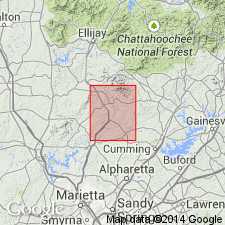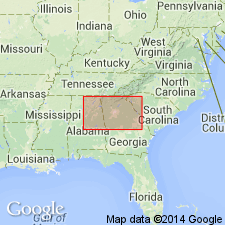
- Usage in publication:
-
- Salem Church granite
- Modifications:
-
- Named
- Dominant lithology:
-
- Granite
- AAPG geologic province:
-
- Piedmont-Blue Ridge province
Summary:
Named Salem Church granite for Salem Church in northwestern GA. Consists of white or light-gray gneissoid granite. Intrudes Hiwassee schist and Great Smoky formation, which is believed to be Cambrian. Unit occupies about 8 sq. mi., extending a little east of Sharp Mountain Creek to west margin of Tate quadrangle. Age is thought to be Precambrian.
Source: GNU records (USGS DDS-6; Reston GNULEX).

- Usage in publication:
-
- Salem Church Gneiss†
- Modifications:
-
- Abandoned
- AAPG geologic province:
-
- Piedmont-Blue Ridge province
Summary:
The Salem Church Gneiss (Bayley, 1928, Dallmeyer, 1975), is here abandoned. It is found to be lithically identical to, and in the same stratigraphic position as, and the same age as the Corbin Gneiss. Its rocks are assigned to the Corbin Gneiss.
Source: GNU records (USGS DDS-6; Reston GNULEX).
For more information, please contact Nancy Stamm, Geologic Names Committee Secretary.
Asterisk (*) indicates published by U.S. Geological Survey authors.
"No current usage" (†) implies that a name has been abandoned or has fallen into disuse. Former usage and, if known, replacement name given in parentheses ( ).
Slash (/) indicates name conflicts with nomenclatural guidelines (CSN, 1933; ACSN, 1961, 1970; NACSN, 1983, 2005, 2021). May be explained within brackets ([ ]).

